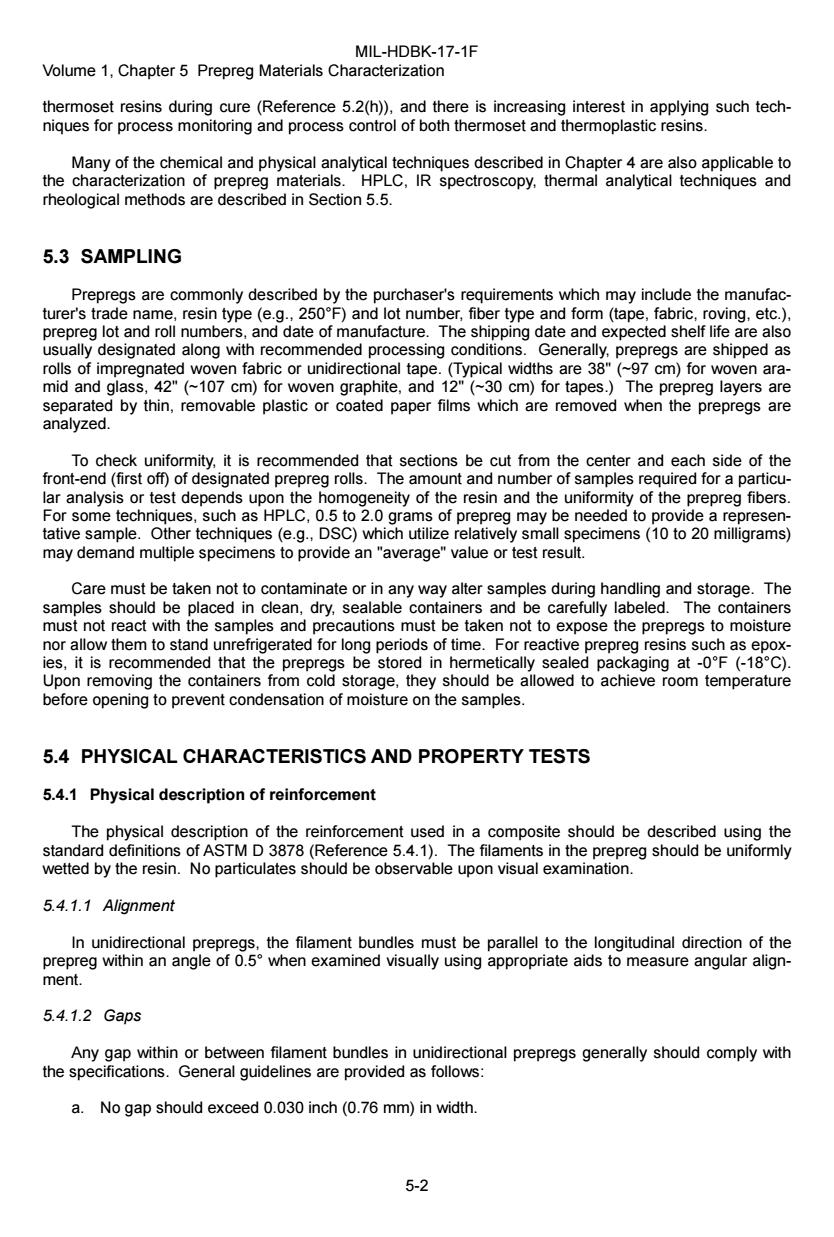正在加载图片...

MIL-HDBK-17-1F Volume 1,Chapter 5 Prepreg Materials Characterization thermoset resins during cure(Reference 5.2(h)),and there is increasing interest in applying such tech- niques for process monitoring and process control of both thermoset and thermoplastic resins. Many of the chemical and physical analytical techniques described in Chapter 4 are also applicable to the characterization of prepreg materials.HPLC,IR spectroscopy,thermal analytical techniques and rheological methods are described in Section 5.5. 5.3 SAMPLING Prepregs are commonly described by the purchaser's requirements which may include the manufac- turer's trade name,resin type (e.g.,250F)and lot number,fiber type and form(tape,fabric,roving,etc.), prepreg lot and roll numbers,and date of manufacture.The shipping date and expected shelf life are also usually designated along with recommended processing conditions.Generally,prepregs are shipped as rolls of impregnated woven fabric or unidirectional tape.(Typical widths are 38"(~97 cm)for woven ara- mid and glass,42"(~107 cm)for woven graphite,and 12"(~30 cm)for tapes.)The prepreg layers are separated by thin,removable plastic or coated paper films which are removed when the prepregs are analyzed. To check uniformity,it is recommended that sections be cut from the center and each side of the front-end(first off)of designated prepreg rolls.The amount and number of samples required for a particu- lar analysis or test depends upon the homogeneity of the resin and the uniformity of the prepreg fibers. For some techniques,such as HPLC,0.5 to 2.0 grams of prepreg may be needed to provide a represen- tative sample.Other techniques (e.g.,DSC)which utilize relatively small specimens(10 to 20 milligrams) may demand multiple specimens to provide an"average"value or test result. Care must be taken not to contaminate or in any way alter samples during handling and storage.The samples should be placed in clean,dry,sealable containers and be carefully labeled.The containers must not react with the samples and precautions must be taken not to expose the prepregs to moisture nor allow them to stand unrefrigerated for long periods of time.For reactive prepreg resins such as epox- ies,it is recommended that the prepregs be stored in hermetically sealed packaging at-0F(-18C). Upon removing the containers from cold storage,they should be allowed to achieve room temperature before opening to prevent condensation of moisture on the samples. 5.4 PHYSICAL CHARACTERISTICS AND PROPERTY TESTS 5.4.1 Physical description of reinforcement The physical description of the reinforcement used in a composite should be described using the standard definitions of ASTM D 3878(Reference 5.4.1).The filaments in the prepreg should be uniformly wetted by the resin.No particulates should be observable upon visual examination. 5.4.1.1 Alignment In unidirectional prepregs,the filament bundles must be parallel to the longitudinal direction of the prepreg within an angle of 0.5 when examined visually using appropriate aids to measure angular align- ment. 5.4.1.2Gaps Any gap within or between filament bundles in unidirectional prepregs generally should comply with the specifications.General guidelines are provided as follows: a.No gap should exceed 0.030 inch(0.76 mm)in width. 5-2MIL-HDBK-17-1F Volume 1, Chapter 5 Prepreg Materials Characterization 5-2 thermoset resins during cure (Reference 5.2(h)), and there is increasing interest in applying such techniques for process monitoring and process control of both thermoset and thermoplastic resins. Many of the chemical and physical analytical techniques described in Chapter 4 are also applicable to the characterization of prepreg materials. HPLC, IR spectroscopy, thermal analytical techniques and rheological methods are described in Section 5.5. 5.3 SAMPLING Prepregs are commonly described by the purchaser's requirements which may include the manufacturer's trade name, resin type (e.g., 250°F) and lot number, fiber type and form (tape, fabric, roving, etc.), prepreg lot and roll numbers, and date of manufacture. The shipping date and expected shelf life are also usually designated along with recommended processing conditions. Generally, prepregs are shipped as rolls of impregnated woven fabric or unidirectional tape. (Typical widths are 38" (~97 cm) for woven aramid and glass, 42" (~107 cm) for woven graphite, and 12" (~30 cm) for tapes.) The prepreg layers are separated by thin, removable plastic or coated paper films which are removed when the prepregs are analyzed. To check uniformity, it is recommended that sections be cut from the center and each side of the front-end (first off) of designated prepreg rolls. The amount and number of samples required for a particular analysis or test depends upon the homogeneity of the resin and the uniformity of the prepreg fibers. For some techniques, such as HPLC, 0.5 to 2.0 grams of prepreg may be needed to provide a representative sample. Other techniques (e.g., DSC) which utilize relatively small specimens (10 to 20 milligrams) may demand multiple specimens to provide an "average" value or test result. Care must be taken not to contaminate or in any way alter samples during handling and storage. The samples should be placed in clean, dry, sealable containers and be carefully labeled. The containers must not react with the samples and precautions must be taken not to expose the prepregs to moisture nor allow them to stand unrefrigerated for long periods of time. For reactive prepreg resins such as epoxies, it is recommended that the prepregs be stored in hermetically sealed packaging at -0°F (-18°C). Upon removing the containers from cold storage, they should be allowed to achieve room temperature before opening to prevent condensation of moisture on the samples. 5.4 PHYSICAL CHARACTERISTICS AND PROPERTY TESTS 5.4.1 Physical description of reinforcement The physical description of the reinforcement used in a composite should be described using the standard definitions of ASTM D 3878 (Reference 5.4.1). The filaments in the prepreg should be uniformly wetted by the resin. No particulates should be observable upon visual examination. 5.4.1.1 Alignment In unidirectional prepregs, the filament bundles must be parallel to the longitudinal direction of the prepreg within an angle of 0.5° when examined visually using appropriate aids to measure angular alignment. 5.4.1.2 Gaps Any gap within or between filament bundles in unidirectional prepregs generally should comply with the specifications. General guidelines are provided as follows: a. No gap should exceed 0.030 inch (0.76 mm) in width